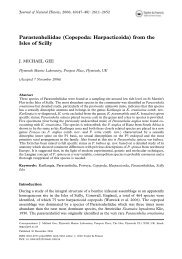An Updated Classification of the Recent Crustacea
An Updated Classification of the Recent Crustacea
An Updated Classification of the Recent Crustacea
Create successful ePaper yourself
Turn your PDF publications into a flip-book with our unique Google optimized e-Paper software.
In <strong>the</strong> superfamily Aselloidea, <strong>the</strong> family Atlantasellidae<br />
has been removed. Brusca and Wilson<br />
(1991) suggested its removal to <strong>the</strong> Microcerberoidea,<br />
where we have placed it. Although Roman and<br />
Dalens (1999) treat <strong>the</strong> family Microcerberidae as<br />
a member <strong>of</strong> <strong>the</strong> Aselloidea, we are keeping it in its<br />
own suborder (Microcerberidea) and superfamily<br />
(Microcerberoidea) as per Bowman and Abele<br />
(1982) (as noted earlier). Thus, <strong>the</strong> Aselloidea presently<br />
contains only <strong>the</strong> Asellidae and Stenasellidae.<br />
The superfamily Stenetrioidea now contains <strong>the</strong><br />
Pseudojaniridae (as noted above), although Roman<br />
and Dalens (1999) have kept it at one family, <strong>the</strong><br />
Stenetriidae.<br />
Within <strong>the</strong> enormous superfamily Janiroidea, <strong>the</strong><br />
Abyssianiridae was removed (incorporated into <strong>the</strong><br />
Paramunnidae) following Just (1990). Species formerly<br />
within that family are now considered to belong<br />
to <strong>the</strong> Paramunnidae. The former families Eurycopidae,<br />
Ilyarachnidae, and Munnopsididae are<br />
now considered subfamilies <strong>of</strong> <strong>the</strong> Munnopsididae<br />
(Wilson, 1989). The Microparasellidae is apparently<br />
polyphyletic; ‘‘some taxa may be moved to <strong>the</strong><br />
Vermectiadidae or put in a new family; Microparasellus<br />
will stay in <strong>the</strong> Janiroidea’’ (Wilson, pers.<br />
comm.). The Janiridae was shown to be nonmonophyletic<br />
by Wilson (1994) but remains a valid<br />
family; some <strong>of</strong> its genera will eventually be reassigned<br />
to o<strong>the</strong>r families. The Katianiridae was described<br />
by Svavarsson (1987). Although <strong>the</strong> family<br />
Pleurogoniidae is recognized by some workers (e.g.,<br />
Roman and Dalens, 1999), we have removed it at<br />
<strong>the</strong> suggestion that it is a junior synonym <strong>of</strong> <strong>the</strong><br />
Paramunnidae (G. Poore, pers. comm.; G. Wilson,<br />
pers. comm.). The family Pseudomesidae was sunk<br />
into <strong>the</strong> Desmosomatidae by Svavarsson (1984).<br />
Although <strong>the</strong> family Santiidae is credited to Kussakin<br />
(1988) by many workers (e.g., Wolff, 1989),<br />
it was first used (in a figure) by Wilson (1987). In<br />
Wilson’s (1987) paper, he acknowledges Fresi et al.<br />
(1980) as <strong>the</strong> source for one <strong>of</strong> <strong>the</strong> phylogenetic<br />
trees in that paper (Wilson’s fig. 5B). However, Fresi<br />
et al. (1980) did not include <strong>the</strong> Santiidae in <strong>the</strong>ir<br />
figure; it was apparently added (and <strong>the</strong>refore first<br />
used) by Wilson (1987). Thus, we have credited <strong>the</strong><br />
family Santiidae to Wilson. Cohen (1998), in his<br />
review <strong>of</strong> <strong>the</strong> family Dendrotiidae, explains why<br />
this spelling <strong>of</strong> <strong>the</strong> family name is preferred over<br />
Dendrotionidae (used by Lincoln and Boxshall,<br />
1983). Interested workers should also consult Roman<br />
and Dalens (1999), whose list <strong>of</strong> families differs<br />
from ours in several respects.<br />
The superfamily Protallocoxoidea and family<br />
Protallocoxidae were removed per G. Wilson (pers.<br />
comm.).<br />
The superfamily Gnathostenetroidoidea contains<br />
<strong>the</strong> families Gnathostenetroididae and Protojaniridae<br />
(following Roman and Dalens, 1999). Additionally,<br />
<strong>the</strong> interesting family Vermectiadidae was<br />
described by Just and Poore (1992), and our tentative<br />
inclusion <strong>of</strong> <strong>the</strong> vermectiadids in <strong>the</strong> superfamily<br />
Gnathostenetroidoidea is based mostly on<br />
<strong>the</strong> recommendation <strong>of</strong> R. Brusca (pers. comm.).<br />
SUBORDER CALABAZOIDA<br />
This family (Calabozoidae) and its suborder were<br />
erected by Van Lieshout (1983). Brusca and Wilson<br />
(1991) suggest that <strong>the</strong> calabazoids are oniscideans<br />
and so <strong>the</strong>y should probably be moved, but we<br />
have not done so in this classification. Wägele<br />
(pers. comm.) points out that <strong>the</strong> ending -oidea<br />
should be reserved for superfamilies and suggested<br />
that we change <strong>the</strong> spelling <strong>of</strong> <strong>the</strong> suborder to Calabazoida,<br />
which we have done.<br />
SUBORDER VALVIFERA<br />
Within <strong>the</strong> Valvifera, several families have been<br />
added since <strong>the</strong> Bowman and Abele (1982) classification.<br />
The family Austrarcturellidae was described<br />
by Poore and Bardsley (1992), and <strong>the</strong> families<br />
<strong>An</strong>tarcturidae, Arcturididae, and Rectarcturidae<br />
were added by Poore (2001b). Poore (2001b)<br />
also recognized <strong>the</strong> Holidoteidae, crediting it to<br />
Wägele (1989), who first suggested it as a subfamily.<br />
Current research shows that <strong>the</strong> family Amesopodidae<br />
is probably a junior synonym <strong>of</strong> <strong>the</strong> Arcturidae<br />
(G. Poore, G. Wilson, pers. comm.), and so<br />
we have removed it, although <strong>the</strong> family was listed<br />
by Roman and Dalens (1999), who did not list <strong>the</strong><br />
Austrarcturellidae. Thus, we recognize 11 families,<br />
4 more than did Bowman and Abele (1982). The<br />
family Arcturidae, credited by Bowman and Abele<br />
(1982) to Sars, is correctly credited to Dana (1849),<br />
and <strong>the</strong> family Idoteidae is correctly attributed to<br />
Samouelle (G. Poore, pers. comm.).<br />
SUBORDER EPICARIDEA<br />
Wägele (1989, pers. comm.) suggested that all <strong>of</strong><br />
<strong>the</strong> epicaridean families we have listed should be<br />
treated as families or subfamilies <strong>of</strong> <strong>the</strong> Cymothoida<br />
Leach (see above). We have not made this ra<strong>the</strong>r<br />
radical change and instead have followed <strong>the</strong> more<br />
conservative classification given by Trilles (1999).<br />
Trilles (1999) divides <strong>the</strong> epicaridean families into<br />
two sections, Bopyrina and Cryptoniscina, which<br />
we have treated as superfamilies (Bopyroidea and<br />
Cryptoniscoidea) to allow a more consistent spelling<br />
and in keeping with our treatments <strong>of</strong> o<strong>the</strong>r<br />
peracarid groups. In <strong>the</strong> Bopyroidea are <strong>the</strong> three<br />
families Bopyridae, Dajidae, and Entoniscidae (all<br />
<strong>of</strong> which were listed by Bowman and Abele, 1982).<br />
In <strong>the</strong> section (now superfamily) Cryptoniscoidea,<br />
Trilles (1999) treats an additional eight families not<br />
listed by Bowman and Abele (1982); <strong>the</strong> family Liriopsidae<br />
has been deleted (see arguments in Grygier<br />
and Bowman, 1990, 1991; Trilles, 1999). Thus, 11<br />
epicaridean families are recognized. The families<br />
added since Bowman and Abele (1982) are not<br />
newly described families but instead represent recognition<br />
<strong>of</strong> formerly described families that were<br />
treated in <strong>the</strong> past, at least by some authors, as<br />
40 Contributions in Science, Number 39 Rationale











